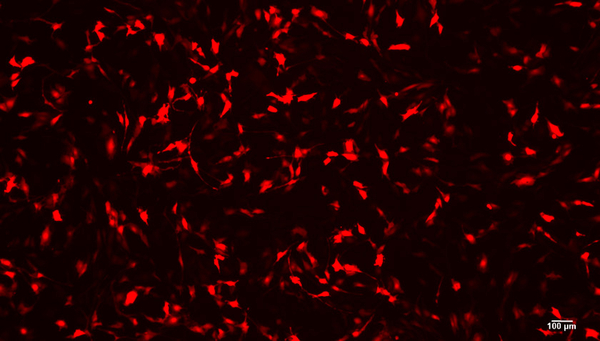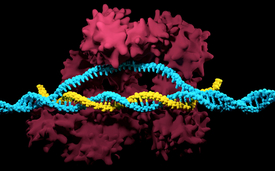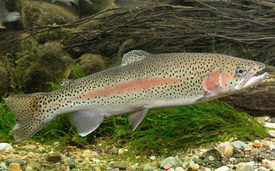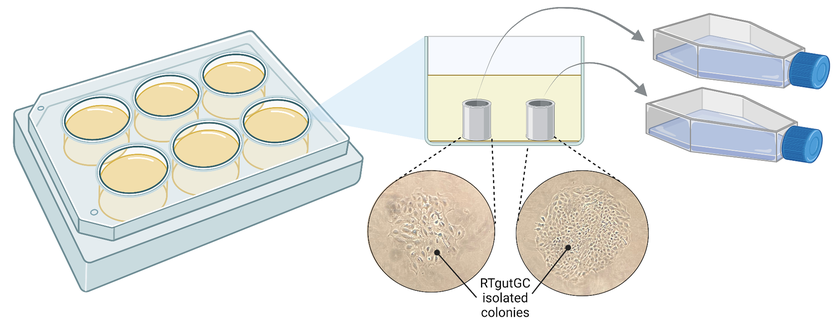News Detail
Cells, cylinders and a vision of the future
September 23, 2021 |
"When I came to Eawag in 2019, I didn't do anything much at first other than to try to get RNA into fish cells," says Marina Zoppo, a postdoctoral researcher at the aquatic research institute Eawag. RNA is a molecule in biological cells that occurs in different forms. Here, the molecular biologist refers to the guide RNA. Its special feature is that it is an important component of the CRISPR/Cas9 system. This molecular biology technique started to revolutionise biology and medicine a few years ago and earned its inventors, Jennifer Doudna and Emmanuelle Charpentier, the Nobel Prize in Chemistry in 2020. The special thing about it is that these "gene scissors" can be used to modify genes much faster and more efficiently than all the techniques known up to that point.
How does CRISPR/Cas9 work?
CRISPR stands for "Clustered Regularly Interspaced Short Palindromic Repeats" - these are certain sections in the genome of bacteria that are repeated multiple times. Cas9 is a protein of these same bacteria. Together, the CRISPR segments and Cas9 form a bacterial defence mechanism against viruses. It works like this: During an infection, the Cas9 protein splits the DNA of the invading viruses into small sequences. These are then inserted between the CRISPR sections of the bacterial genome. If the same virus infects the cell again, it can be quickly recognised and warded off thanks to these DNA fragments.
In genetic engineering, the system is used to mutate genes precisely. The Cas9 protein gets linked to the "guide RNA". This RNA sequence finds the target DNA encoding for the protein of interest in the cell nucleus and binds to it. Cas9 then cuts the DNA of the target organism at this point. This calls the cell's own repair system to the scene, which repairs the break. As this does not always happen without errors, however, a mutation occurs in the target gene. Furthermore, it is possible to introduce additional sequences into the cell with the guide RNA, which are then incorporated into the target gene.
The CRISPR/Cas9 complex with the Cas9 protein (red), the guide RNA (yellow) and the target DNA (blue).
(Photo: iStock, Meletios Verras)
The problem with the cell membrane
While CRISPR/Cas9 has been widely used for mammalian cells to produce genetically modified cells, there was nothing like it for fish. Zoppo, who had completed her doctorate at the University of Pisa in 2018, came to Eawag's Environmental Toxicology department with a clear mission: to establish the method for fish cells, more specifically for cells of rainbow trout.
The researcher brought a lot of experience with the method to Eawag. But she recalls: "I was somewhat surprised by the amazing resistance of the fish cells to manipulation. I had not found this before with any other type of cell". But the reason for this is obvious, explains the biologist: as coldwater fish, rainbow trouts have a different cell membrane composition than mammals do. Their cell membrane is therefore much more rigid. Zoppo accepted the challenge, experimented with electrical voltage and impulses to find the right combination of the two to make the cell membrane permeable for the RNA molecules and proteins (this method is called electroporation). Eventually, she was successful and was able to introduce the guide RNA into the cell along with the Cas9 protein needed for the gene scissors, only to be faced with the next problem.
The problem with the mutants
The scissors had successfully boarded the cells and worked its magic there: It had precisely located the gene selected by Zoppo on the rainbow trout genome, changed the DNA sequence there and created a so-called knock-out mutation in the gene. This means that due to the mutation in the DNA sequence, the gene could now no longer carry out its usual role in the cell: an excellent experimental system for the researcher to study this very role of the gene. "We observe what happens when a cog in the system fails. In this way, so far poorly understood gene functions can be elucidated," explains Zoppo.
However, there was a small problem. It is one of the properties of the CRISPR/Cas9 system that a gene can be mutated as desired, but: The exact DNA sequence that is created in the process is randomly formed in each cell. "Because we had used several cells for the experiment, each cell now had its own DNA sequence," says Zoppo. The researcher's task was now to pick out a "mother cell" from these and multiply it so that a cell line of genetically identical daughter clones was created. "Here, however, the fish cells again proved to be astonishingly unconventional," says Zoppo. "None of the conventional and widely used methods I knew and tried were applicable here. It just didn't work," says Zoppo.
The breakthrough finally came with an older method using simple cloning cylinders. When cells multiply in culture, they form colonies around the mother progenitor cell, which can be isolated with the cylinder and transferred to another plate. "It's actually quite simple once you get the hang of it," says Zoppo.
Mutated cells were seeded at low density in a six well plate. Colonies of genetically identical cells formed, which were isolated using cloning cylinders and transferred to a larger vessel. Figure created using biorender.com.
(Graphic: Eawag, Marina Zoppo)
Why does Eawag work with fish cell lines?
Marina Zoppo conducted her experiments on the “RTgutGC” cell line. These are cells obtained from the intestine of rainbow trout and further cultivated as a cell line in the laboratory. In toxicological research, i.e. when one observes the harmful effects of environmental influences on organisms, cell lines become increasingly important compared to tests with living animals. This is due to the fact that, on the one hand, animal experiments can be avoided and that, on the other, the cell lines also offer concrete research advantages: They allow processes that are difficult to monitor in live animals to be observed, and the tests are easier to repeat and can be more flexibly designed.
In environmental toxicology, researchers investigate whether the cells of a genetically modified cell line react differently to specific chemicals than the cells of the wild type. This allows them to find out which genes play a role in the response to the chemical by the cell.
The future: screening techniques
By using the method established by Marina Zoppo, researchers in the Department of Environmental Toxicology can now mutate any gene in the rainbow trout to study its function more precisely. "This is a great new genetic tool. It allows me to create a mutant cell line in a few weeks with unprecedented ease and precision. With conventional methods, this used to take several months," notes the researcher.
In the future, she aims at miniaturising the technology. She shows Petri dishes with 24 indentations. A different guide RNA could be inserted into each indentation, thus 24 different genes could be modified simultaneously in each plate. "The plate is then exposed to a chemical and we can see at a glance which mutations play a role in the context of this chemical," Zoppo says in outlining her vision. With this CRISPR/Cas9 genetic screening, which is being used more and more around the world - but not yet with fish cells – ecotoxicological tests will become even faster and cheaper to perform. Not surprisingly, Zoppo wants to establish the method for rainbow trout cells. It might take some time to do so, but she leaves no doubt that she will succeed.
Cover picture: Eawag, Marina Zoppo




